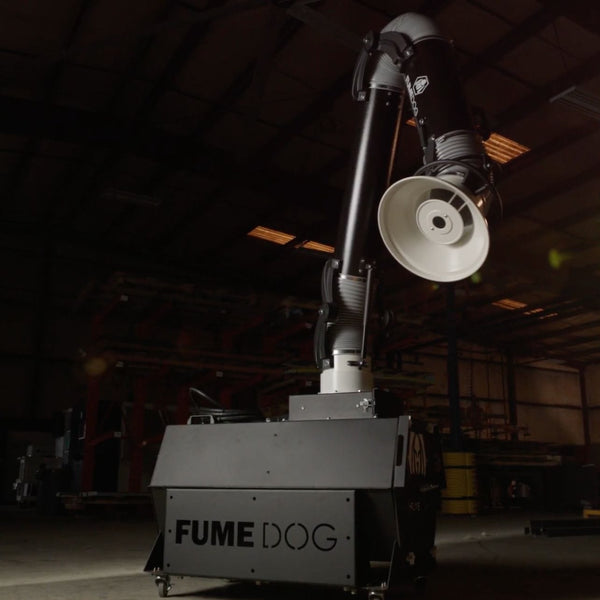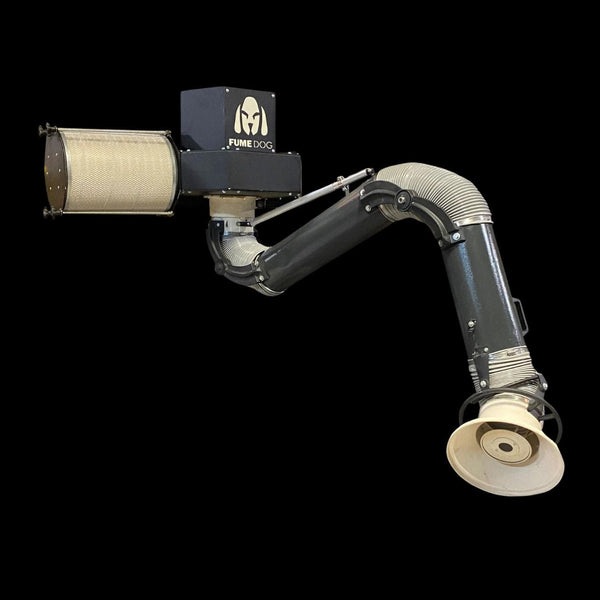
Do you ever wonder if welding fumes are toxic? Spoiler alert: Yes, they can be.
Breathing these fumes can lead to serious health risks, like lung cancer and metal fume fever. This article will break down the dangers and how to protect yourself.
Keep reading—you'll want to know this!
Key Takeaways
- Welding fumes contain harmful metals like chromium, manganese, and lead. These particles can reach deep into your lungs and cause serious health risks.
- Different welding processes produce varying levels of toxic gases such as ozone, nitrogen oxides, carbon monoxide, and carbon dioxide. Each type of metal being welded also alters the toxicity.
- Coatings on metals release additional toxic fumes when heated during welding. Zinc, cadmium, nickel, and chromium coatings increase the risk of respiratory diseases like bronchitis and metal fume fever.
- Proper ventilation systems are essential to reduce exposure to hazardous welding fumes. Fresh airflow helps remove dangerous particles from the workspace.
- Using Personal Protective Equipment (PPE) significantly reduces health risks associated with welding fumes. Education on handling these hazards is crucial for maintaining a safe work environment.
Looking for the Best Welding Fume Extractors in the Industry?
Look no further! Contact Fume Dog today for top-of-the-line solutions that ensure a cleaner, safer, and more efficient workspace. Don't compromise on quality—reach out to us now and experience the Fume Dog difference!
Call us at +1 800 980 3481 or email us at sales@fumedog.com to learn more.
Understanding Welding Fumes

Welding fumes are like the smoky cocktail of metal particles hanging in the air. They come in various flavors depending on what you’re welding and how you're doing it.
Definition
Welding fumes are a complex mix of fine and ultrafine particles that can reach deep into your lungs. They often contain toxic metals like chromium, manganese, and lead. These tiny metal bits come from the welding materials and the coatings on those materials.
Toxic gasses such as ozone, nitrogen oxides, carbon dioxide, and carbon monoxide also form during common arc welding processes. The type of metal being welded—like stainless steel or mild steel—and any surface coatings impact the exact composition of these fumes.
Composition variation
Welding fumes aren't your average puff of smoke. These nasty little clouds pack a punch with a mix of metals and chemicals straight outta the periodic table. Stainless steel welding fume, for instance, throws in chromium and nickel—superstars no one asked for! Breathing this toxic metal cocktail is like signing up for trouble.
Industrial welders typically show higher urine levels of manganese (Mn) and chromium (Cr), putting them at risk.
The variety only adds spice to this dangerous brew. Metal fumes from different processes bring their own toxic flavors—lead, cadmium if you're into that sort of thing—or not! A nice cocktail could include anything depending on what you're welding today: stainless steels or regular old iron? The type matters because inhaling these hazardous substances directly messes with your cardiovascular system just like Particulate Matters (PM).
Effects of coatings
Ever welded on a coated metal and found yourself coughing up a storm? That's the effect of coatings like zinc, cadmium, nickel, chromium, and paints. These bad boys don't just stay put; they increase the volume of fumes emitted during welding.
Inhaling these nasty fumes can turn your lungs into an angry volcano with symptoms like metal fume fever, bronchitis, and other long-term lung conditions.
So next time you think about skimping on ventilation—think again! Coated metals are out to get you if you're not careful. Welding fumes from these materials are far more toxic compared to uncoated ones.
Taking short cuts with safety measures may lead you straight to respiratory issues or worse.
Are welding fumes toxic?
Welding fumes? Toxic might be an understatement! That visible smoke isn’t just annoying—it’s a cocktail of harmful metal fume and gas by-products. Inhaling those fine particles can mess with your lungs' immune defenses.
It’s so serious that the IARC has classified mild steel and stainless steel welding fumes as Group 1 carcinogens, which is their fancy way of saying "definitely cancer-causing."
Just think about it, exposure to welding fumes means you're flirting with danger in every breath you take. The National Institute for Occupational Safety and Health (NIOSH) even recommends more studies on these toxic clouds because they’re concerned about long-term effects.
So next time you pick up that welding torch, imagine inhaling a hazmat suit's worst nightmare.
Factors Affecting Exposure to Welding Fumes

The type of welding process you choose can dramatically influence your exposure to toxic fumes. Dig deeper into the specifics!
Type of welding process
Different types of electric arc welding processes, like MMAW (Manual Metal Arc Welding), FCAW (Flux-Cored Arc Welding), and SAW (Submerged Arc Welding), can produce varying levels of fumes.
Inhaling welding fumes from these processes isn't just a minor hiccup; it's dangerous business. Each method releases different metals and gases into the air, making some more toxic than others.
Shielding gases used in Gas Metal Arc Welding crank up ultraviolet radiation, leading to more ozone and nitrogen oxides in your workspace. These bad boys can mess with your respiratory system big-time if you don’t have proper ventilation or local exhaust ventilation systems in place.
So, yeah—choosing the right process isn’t just about getting the job done but keeping those lungs happy too!
Type of coating
Coatings like zinc, cadmium, nickel, chromium, and various paints can really mess with the boiling point of your work metal. Why? Because these coatings create nasty fumes when heated.
So yeah, welding over that shiny layer of paint ain't just a bad idea—it turns toxic fast.
Vapors or fumes don’t just magically appear; they come from those sneaky residues on the metal you're working on. Think about it—one minute you’re welding happily away, the next you’re inhaling something nastier than your ex’s new mixtape.
Coatings are crucial in determining how dangerous those welding fumes become.
Ventilation
Ventilation ain't just a fancy word; it's your best buddy in the welding world. Got metal particles floating around? A proper ventilation system zaps them out faster than you can say "welding fumes dangerous." It keeps those nasty bits from setting up camp in your lungs, which is pretty crucial if you enjoy, well, breathing.
Welding in confined spaces without extra ventilation? That's like inviting trouble to dinner and serving it dessert. Proper systems not only pull out harmful gases but also keep the air as fresh as a mountain breeze—or at least less toxic.
So gear up and get those vents running!
Duration of exposure
Welders exposed to aluminum TIG welding fumes for a mere 60 minutes saw spikes in urinary 8-OHdG and plasma 8-OHdG. Imagine what could happen with long-term exposure! Welders also produce about 3-to-4 times more urine manganese and chromium concentrations compared to their non-welding pals.
This isn't just a fun fact; it’s a flashing neon warning sign.
Longer you breathe in those fumes, the more likely you’ll end up with bone and joint problems that make cracking like a glow stick sound enviable. So next time you think an extra hour won’t hurt, maybe reconsider unless you're aiming for a new career as a human pretzel.
Hazards of Welding Gasses
Watch out for those invisible threats! Welding gases can cause serious harm to your lungs and might even lead to fatal incidents.
Examples
Ironically, the air isn’t as clear as it seems when you’re knee-deep in a welding project. Consider stainless steel welders; they have nearly double the risk of getting lung cancer! A 2006 meta-analysis pegged the relative risk for these folks at 1.29.
It’s like playing Russian roulette with fumes instead of bullets.
Those pretty colors on metal? They’re not just eye candy—they're coated with trouble. These coatings can release harmful substances, adding more toxicity to welding fumes. So next time you're admiring that shiny finish, think twice about what else it might be offering besides good looks!
Effects on respiratory health
Breathing in welding fumes is like inhaling a cocktail of nastiness that can torch your lungs. These fumes swarm into your respiratory system and bring inflammation, lung defense suppression, oxidative stress—the whole shebang.
Over time, this toxic invasion can damage DNA and even have genotoxic effects. Welders face a higher risk of pneumococcal pneumonia thanks to their daily dose of disgusting particles.
Welding fumes? They're not just irritating; they play the villain with serious gusto by being both toxic and carcinogenic. This means long-term exposure could lead you to some nasty respiratory diseases down the line.
It's like signing up for a free trial of misery!
Potential for fatal incidents
Imagine you're in a tight, confined space with welding fumes thicker than your aunt's secret gravy recipe. Inhaling those fumes can lead to asphyxiation quicker than you can say "ventilation." Working without proper safety measures is like playing hopscotch on hot coals—dangerously foolish.
Excessive exposure to welding gases isn't just bad for your health; it could be downright fatal.
Welders dealing with asbestos insulation face grim prospects: think asbestosis, lung cancer, and mesothelioma making unwanted house calls. And let's not forget our old pal manganese! Breathing in too much of this sneaky gas might leave you doing a shaky impersonation of someone with Parkinson’s disease.
Prevention and Safety Measures
Face it, nobody looks good in a hospital gown, so wear that protective gear! Proper ventilation is a must unless you're into breathing toxic air. Know how to handle welding fumes like a pro, ditch those dodgy coatings correctly, and keep confined spaces for your meditation sessions only.
Protective equipment (Fume Dog)
Slip into something safer with Fume Dog's fume extraction systems. These bad boys are tailor-made to suck up those nasty welding fumes before they mess with your lungs. You won't even know they're there, but your respiratory system will thank you.
Slapping on some Personal Protective Equipment (PPE) is a no-brainer too. Throw in the best air quality improvements from Fume Dog and you're golden! With these tools, you'll be dodging both acute and long-term occupational hazards like a pro—keeping yourself healthier while looking cooler than ever in that gear.
Proper ventilation
Got a workshop that breathes like a claustrophobic shoe box? Time to crank up the ventilation. Proper airflow is your best buddy against nasty welding fumes, which are basically your lungs' worst enemy.
Good mechanical ventilation systems keep those harmful particles at safe levels and save you from playing respiratory roulette.
Don't rely on just opening a window. You need sufficient capacity here, folks! The idea is to reduce exposure and let fresh air swoop in like a superhero. It's all about keeping the space breathable; otherwise, you might end up taking sick days for reasons more serious than missing Monday Night Football.
Education on handling welding fumes and gases
Knowledge is power, they say. And in welding, it can save your lungs! Health education intervention has worked wonders by significantly boosting awareness and PPE use among electric arc welders.
Imagine a world where more than just 35.9% of welders actually used PPE—that's the dream, right? Proper training not only covers how to wear protective gear but also teaches about ventilation techniques and the importance of disposing coatings properly.
Ever found yourself stuck in a haze of toxic fumes? It’s not just annoying; it’s dangerous. Effective education programs demystify these hazards and arm you with practical tips for handling them safely.
This includes understanding different types of gases released during welding and their impacts on respiratory health. Spotting potential risks quickly helps create safer working environments instantly.
So gear up, vent well, and breathe easy!
Proper disposal of coatings
Grinding those gnarly coatings? Bad idea. The dust you kick up can be more toxic than your ex's vibes. Instead, opt for wet slurry vacuum removal techniques. These are designed to suck up even the nastiest toxins without releasing them into your breathing space.
Make sure to strip off any coatings from the weld area before firing up that torch. Leaving them on is like welding through a cloud of doom—definitely not fun! Proper disposal methods protect both welders and our lovely planet, keeping everyone breathing easy and living longer.
Prevention of exposure in confined spaces
Welding in confined spaces? That's like trying to run a marathon in a phone booth—bad idea! Welders face higher risks of fire, explosion, and asphyxiation due to poor ventilation.
Use proper ventilation systems and substitute less hazardous materials when possible. Always ensure clear escape routes because no one enjoys playing trapped!
Control methods are crucial for safety. Proper disposal of coatings will help minimize toxic fume buildup. Implement regular air quality checks and use protective equipment religiously.
Training on safe handling techniques can be lifesaving, so hammer those protocols home!
Conclusion
Still wondering if welding fumes are toxic? Well, they’re not exactly perfume mist. Those fumes can mess up your lungs faster than you can say "respiratory distress." And let's not forget the fun side effects like eye burns and skin problems.
Stay sharp and gear up with proper equipment.
FAQs
1. Are welding fumes harmful to your health?
Yes, welding fumes are toxic and can harm your health. They contain metals and gases that can cause lung disease.
2. What substances are found in welding fumes?
Welding fumes have dangerous chemicals like manganese, chromium, nickel, and carbon monoxide.
3. How can you protect yourself from toxic welding fumes?
Use proper ventilation systems and wear protective gear like masks to reduce exposure to the toxic substances in welding fumes.
4. Can long-term exposure to welding fumes lead to serious health issues?
Long-term exposure to these toxins can cause chronic respiratory problems and increase the risk of cancer.





